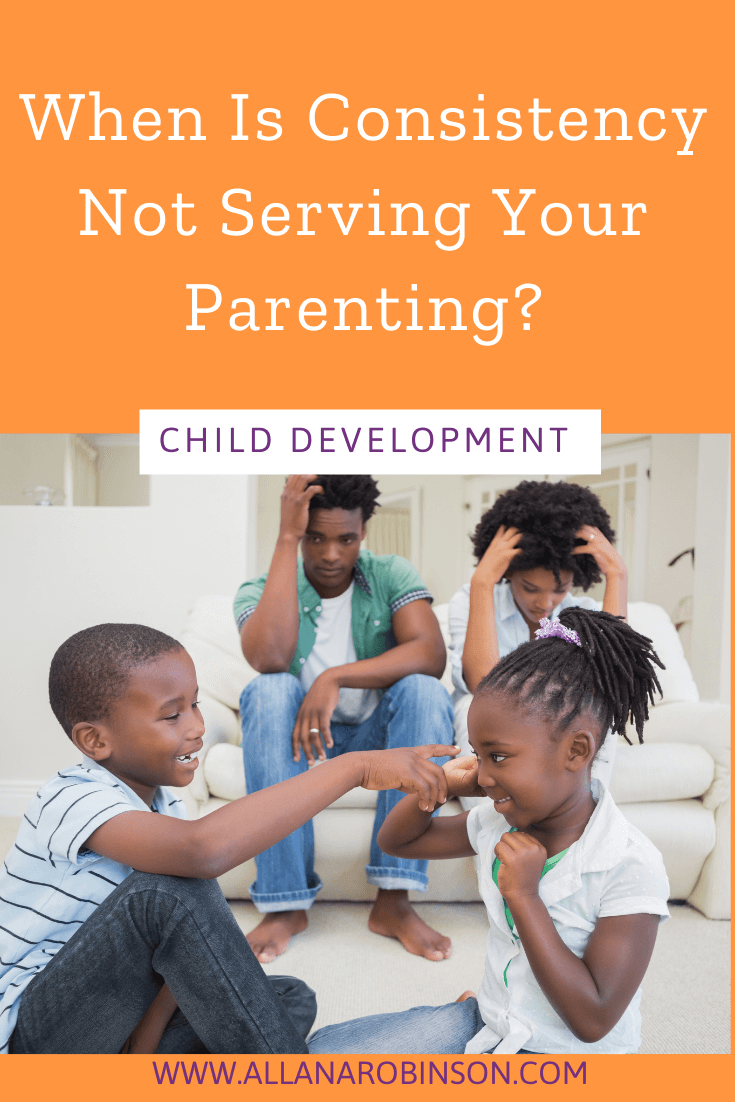Often I get parents coming to me and saying “I’ve done everything I know how to do! I’ve done ABC and XYZ and my kids are still misbehaving! I’ve been consistent just like you said!” When a parent comes to me with a laundry list of stuff they’ve tried, I have to wonder how consistent they’ve actually been. In order to try all that stuff you’ve probably been consistent for like a month or two at best. All in all, consistency isn’t the only important ingredient here. If you’re consistently doing something that isn’t moving you towards your goal, it doesn’t matter how consistent you are, you’re going to stay stuck.
Sometimes consistency doesn’t serve you.
Consistently spanking your child is teaching them that hitting is an acceptable way to work out your frustrations. Consistently putting your child in time-outs taught them that shunning and isolating people is how to resolve conflict. Consistently using a sticker chart is highlighting your child’s failures on an ongoing basis. Consistently talking to your children about their behaviour when they aren’t calm and offering no alternatives that meet their needs, just stresses them out. And consistently ignoring them is teaching them that when someone does something undesired, they should abandon them.
It takes consistency doing the right things at the right time for consistency to work.
I saw a meme on Instagram the other day that said “When you continue to be irritated by someone who refuses to change, you are also refusing to change.” This reminded me of another quote that is attributed to Einstein, “The definition of insanity is doing the same thing and expecting different results.” I suggest the interpretation to mean that if you’ve been consistent with something (months to years, not trying it out for a couple of weeks or a couple of days) and you’re not seeing any improvement, then it’s time to try something new! It’s time to look critically at what you’re doing and at the very least to tweak it or troubleshoot it. That doesn’t mean you have to throw the baby out with the bath water – which is what happens when you jump around from strategy to strategy.You need to look at what’s working and what isn’t and try something new for the stuff that isn’t.
One of the problems with these punitive strategies like spanking, time-outs, and sticker charts, is that they don’t leave you anywhere to go. There’s no way to tweak or troubleshoot them, because they’re so focused on condemning bad behaviour vs teaching how to behave well. With these strategies you consistently told your kids what not to do. That hasn’t worked, so it’s time to do the opposite and teach them what to do! Stop wasting your energy! Get out of your box, find a new way to say it or ask it. Find a new way to show them what you want from them and how to do that.
Ready to be a wizard with words during your kiddo's next tantrum tornado? Sign up for our 'Parenting Power Phrases' mini-course! This magic scroll of wisdom will equip you with the perfect phrases to tame those baffling behaviors from your toddler, preschooler, or kindergartener. Be prepared, be confident, and ace the next curveball your little one throws your way!
Take this as an example:
One of my clients said her son is completely refusing to pick up his room anymore, it’s becoming a huge multi-day family-wide battle every week and she’s just over it. I asked her what she’d tried and she gave me a huge list of strategies. In the process of listening to her list it all out, I saw a gap she didn’t see because she was too close to it. She was too emotionally involved in it – which is so often the case with our kids, me included!
I knew two things about her son: he is terrified of illness and he’s really into emergency services. So I asked “Have you approached this from a health and safety standpoint? Like, use the same tools but instead of centring your desire for a clean house, centre his health and safety?” She said, “NO! But that’s genius! You’re right that is my concern, and that is also his concern!” They had a common concern! She just couldn’t see it because she was too close. She didn’t have to reinvent the wheel. She didn’t have to abandon everything she’s been doing for the last several years. She just needed a tweak to her approach.
It’s not unusual for my clients to hear a tweaking suggestion I give them and for them to say “Omg that’s so obvious, why didn’t I think of that?!” A lot of time, yes, we are too close to the situation to see it clearly, but the main reason is because usually they’re still stuck in trying to figure out how to stop the behaviour they don’t want instead of collaborating with their child.
Consistently doing something that isn’t getting you results, is going to consistently not get the results you’re looking for.
We’ve spent our whole lives being taught what not to do, so that’s easily within our wheelhouse. Flipping your thinking from punishment to teaching takes practice, patience, and accountability. That’s why the Parenting Posse is as popular as it is. That’s why ParentAbility has a very low turnover rate and some members have been members for years, as it’s a lot easier to make changes stick with accountability. It’s a lot easier to make changes when you have a community to debrief with and talk it through with. The community is the difference between trying to reinvent the wheel and just improving upon the wheel.
The more we tweak and troubleshoot, the more our kids are also gaining better skills so that eventually we don’t actually have to tweak or troubleshoot anything, they’ll come to us to tweak and troubleshoot.
Back to that meme, if you are constantly irritated that your children won’t change, but you’re also not changing your approach or trying new angles, then you are modelling that rigidity for your children and nothing is going to improve. Children are our mirrors and they reflect what they see. Change the base angle of your strategy and switch away from manipulation or highlighting their failures, instead motivate your children! If you are ready to start something new, grab my scripts: Scripts to Manage Crazy-Making Behaviour. It’s a collection of 10 one-liner scripts to address 10 different behaviours, and I explain why the scripts work, and how to continue the conversation beyond that first opening line. They’re totally free, and I love them because they’re just a great example of how when we change our behaviour and start teaching, our children follow suit and their behaviour changes.













